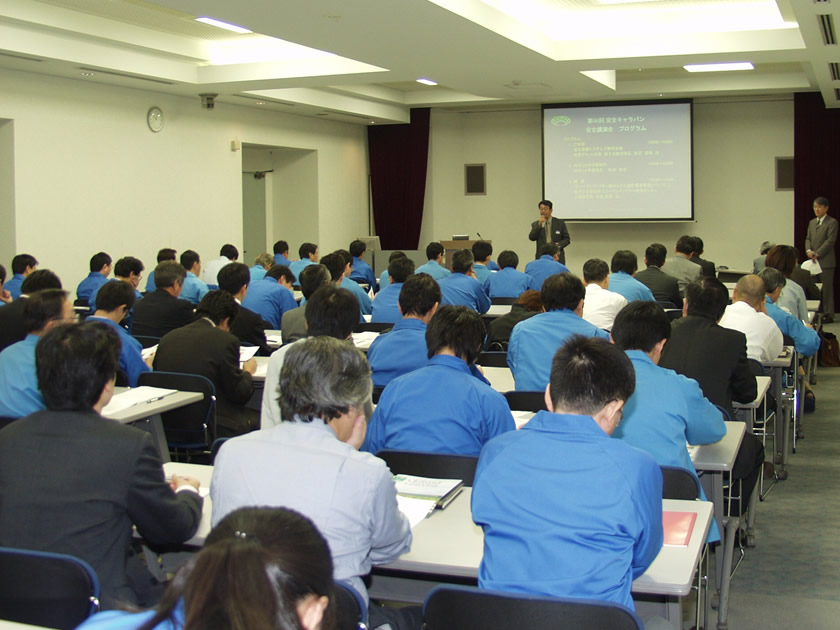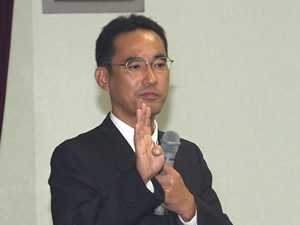|

Safety Presentation

Mr. Nagasaka
|
 About 70 persons, including the employees of Fuji Electric Systems Co., Ltd. and cooperating companies, attended the Safety Presentation. About 70 persons, including the employees of Fuji Electric Systems Co., Ltd. and cooperating companies, attended the Safety Presentation.
 At the beginning of the presentation, Mr. Toshihiro Akisada, General manager Nuclear Power Division, Power Plant Group, Fuji Electric Systems Co., Ltd, gave an address and said, At the beginning of the presentation, Mr. Toshihiro Akisada, General manager Nuclear Power Division, Power Plant Group, Fuji Electric Systems Co., Ltd, gave an address and said,
"I believe that everyone understands that ensuring safety is the utmost importance in every field, needless to mention the nuclear power fields.I also think in order to ensure safety, mechanisms for performing works are important. We should establish quality management systems and carry out our operations based on them. By doing so we should comply with rules and laws. We should genuinely regard these mechanisms and keep high awareness about safety.
From today's lecture and introduction of NSnet activities, we will be able to acquire insights about these mechanisms, working methods, and the like, and this will certainly raise our motivation for safety.”
 After the address, Mr. Machida, General Manager of NSnet, introduced NSnet activities, and this was followed by a lecture entitled "Regarding Human Factors Requirements in Design" delivered by Mr. Akihiko Nagasaka, Senior research Scientist Human Factors Research Center, Socio-economic Research Center, Central Research Institute of Electric Power Industry. After the address, Mr. Machida, General Manager of NSnet, introduced NSnet activities, and this was followed by a lecture entitled "Regarding Human Factors Requirements in Design" delivered by Mr. Akihiko Nagasaka, Senior research Scientist Human Factors Research Center, Socio-economic Research Center, Central Research Institute of Electric Power Industry.
 He said, "As a background for the birth of the concept of human factors, we find the problem of human alienation in the case of operators working on an assembly line, and crash accidents of fighter aircraft during the Second World War. No matter how reliable machines may be, if they are not well suited for use by humans, unforeseen situations may appear. Various issues are being addressed as human factors requirements in design, starting from the idea of 'designing to adapt machines to humans, not to adapt human to machines'. He said, "As a background for the birth of the concept of human factors, we find the problem of human alienation in the case of operators working on an assembly line, and crash accidents of fighter aircraft during the Second World War. No matter how reliable machines may be, if they are not well suited for use by humans, unforeseen situations may appear. Various issues are being addressed as human factors requirements in design, starting from the idea of 'designing to adapt machines to humans, not to adapt human to machines'.
 These requirements have been researched in various fields until today. The US Department of Defense has been addressing the issue since long ago, and results of this research have been compiled in documents such as NUREG-0700. At the Central Research Institute of Electric Power Industry, we have compiled the 'Human Factors Requirements for On-Site Control Panels' while referring to the Japanese Industrial Standards (JIS), standards of the Japan Electrical ManufacturersC Association (JEMA), and NUREG-0700. In these requirements, we have covered panel layout considering the height of installation of instruments, general panel layout for placing meters, operation switches, etc., and general rules regarding the meaning expressed by colors. These requirements have been researched in various fields until today. The US Department of Defense has been addressing the issue since long ago, and results of this research have been compiled in documents such as NUREG-0700. At the Central Research Institute of Electric Power Industry, we have compiled the 'Human Factors Requirements for On-Site Control Panels' while referring to the Japanese Industrial Standards (JIS), standards of the Japan Electrical ManufacturersC Association (JEMA), and NUREG-0700. In these requirements, we have covered panel layout considering the height of installation of instruments, general panel layout for placing meters, operation switches, etc., and general rules regarding the meaning expressed by colors.
 According to the human factors requirements in design, an emergency diesel generator control board was re-designed on paper. In this re-design, the control board was made to agree in physical function, physiological function, population stereotype, etc. by placing meters and swithes at appropriate height, and grouping them by system functions, etc." According to the human factors requirements in design, an emergency diesel generator control board was re-designed on paper. In this re-design, the control board was made to agree in physical function, physiological function, population stereotype, etc. by placing meters and swithes at appropriate height, and grouping them by system functions, etc."
|
 At the safety information exchange session, we asked Mr. Toshio Suzuki, Department Manager, Nuclear Systems Quality Assurance Management Department, Nuclear Systems Quality Assurance Division, Nuclear Systems Division, Power Systems Hitachi, Ltd., to give an in-depth explanation about the good practices cited by the peer review regarding "Computerization of Information Transmission and Design Management in Design Departments". At the safety information exchange session, we asked Mr. Toshio Suzuki, Department Manager, Nuclear Systems Quality Assurance Management Department, Nuclear Systems Quality Assurance Division, Nuclear Systems Division, Power Systems Hitachi, Ltd., to give an in-depth explanation about the good practices cited by the peer review regarding "Computerization of Information Transmission and Design Management in Design Departments".
 The main information and opinions exchanged included: The main information and opinions exchanged included:
- |
"Are all documents, such as design and research proposals also registered in the Design Document Management System?" |
- |
The Design Document Management System is realized according to the workflow, and everything is registered in it. |
- |
Does every person in charge individually carry out registration with the Design Document Management System? |
- |
The Registration Center receives applications for document registration. |
- |
Is submission of documents to the Registration Center carried out using original paper plans? |
- |
Yes, original paper plans are used. After registration, documents converted to electronic media are handled as the original documents. |
|







